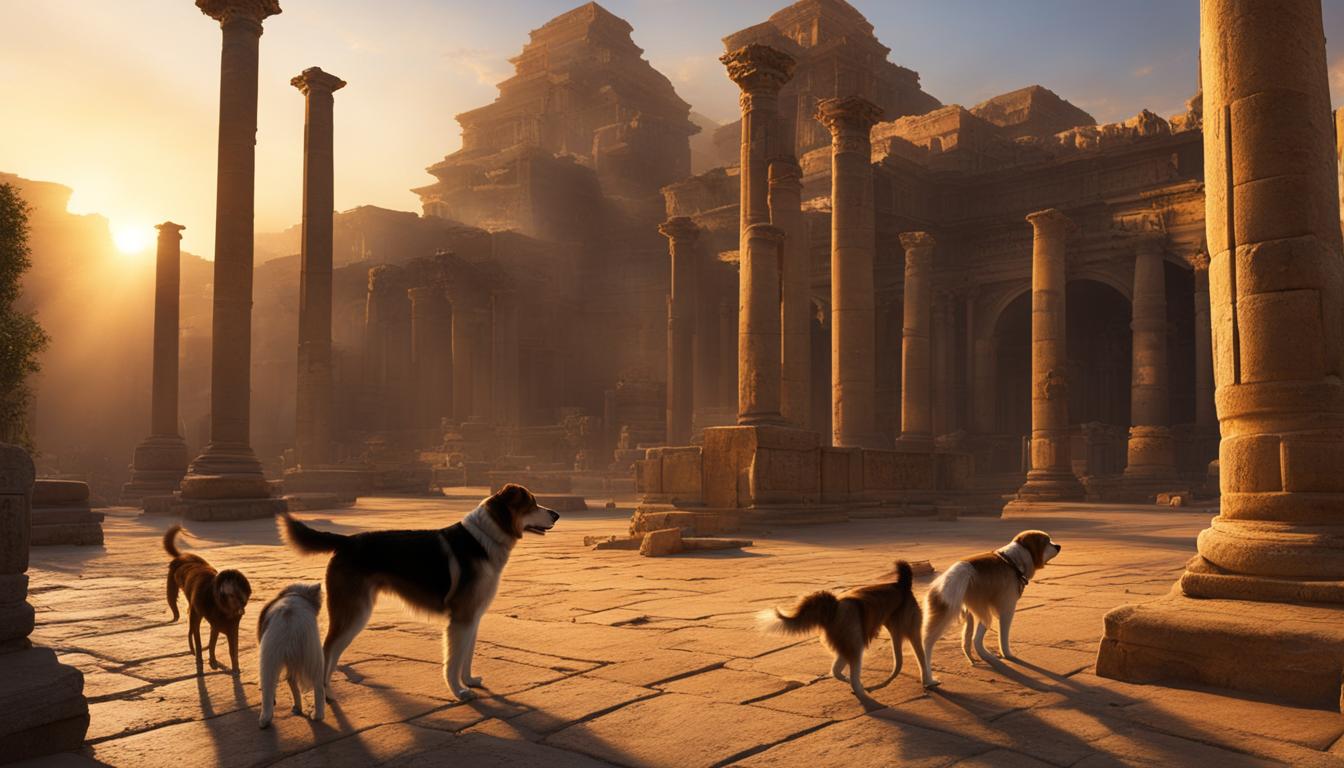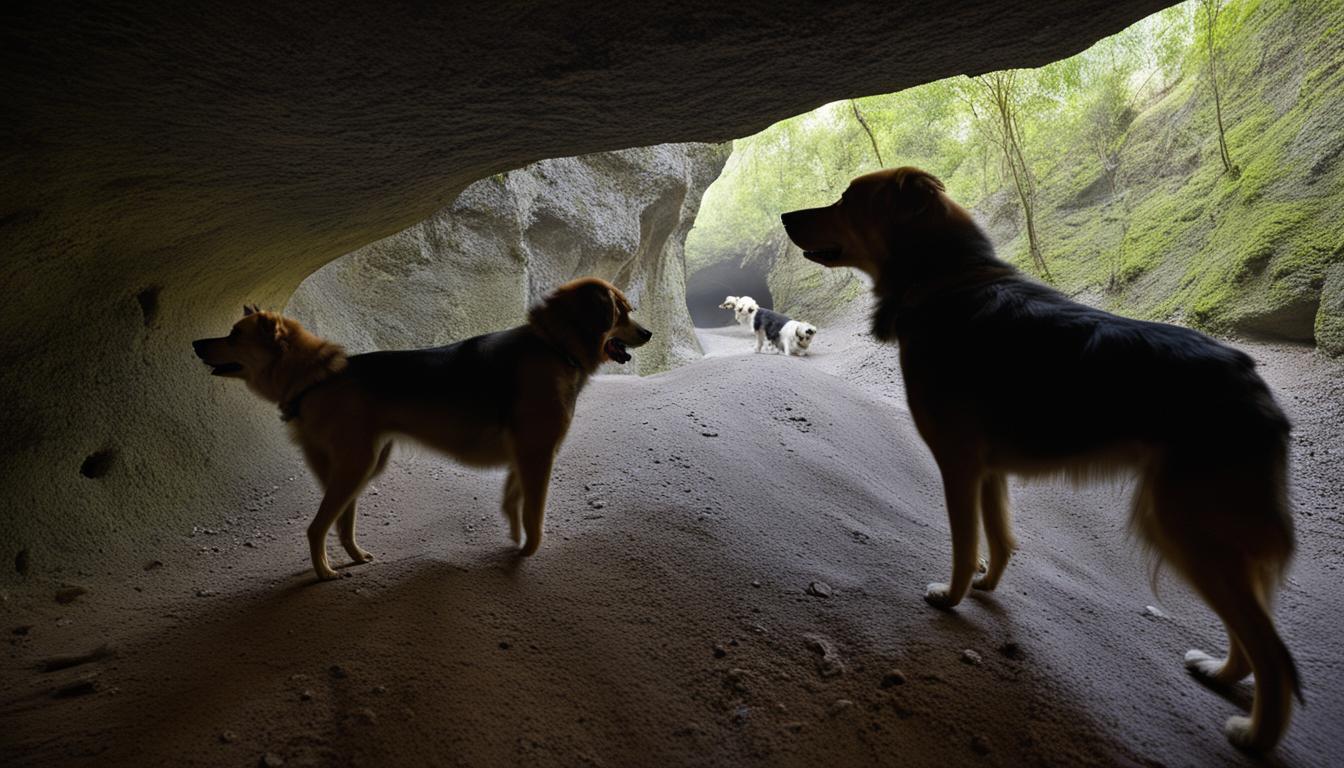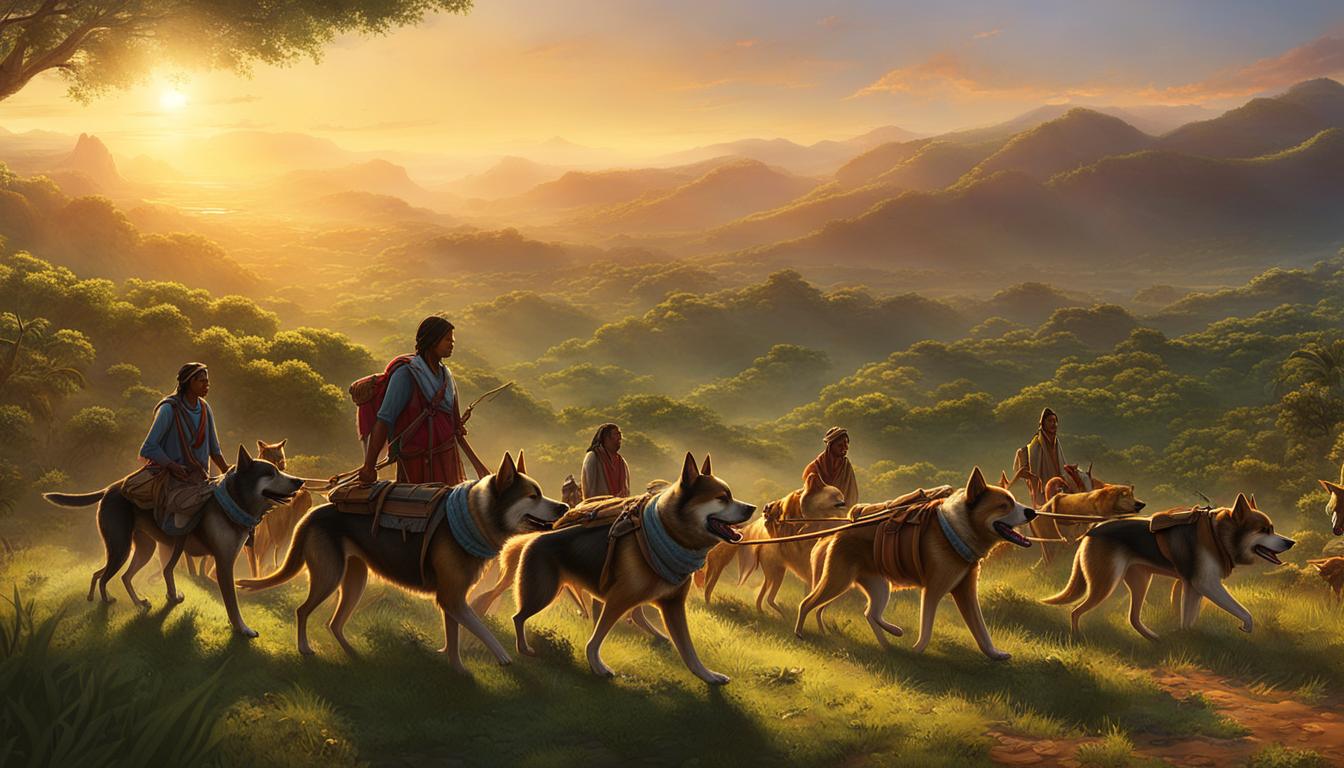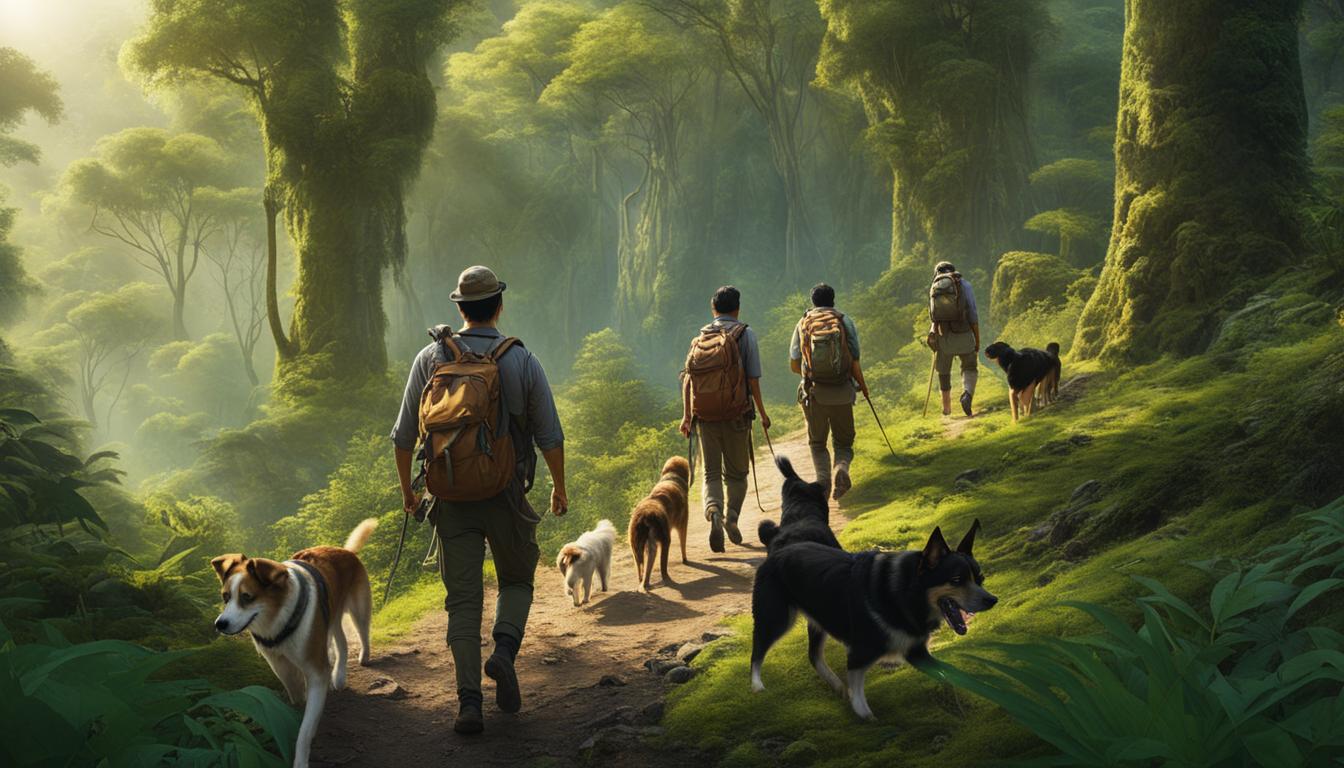Have you ever wondered about the important role dogs played in ancient civilizations? Dogs have been our loyal companions for centuries, and their presence in the past is no exception. From ancient Egypt to the Aztecs, these four-legged friends were revered, celebrated, and even believed to hold supernatural powers.
In ancient times, dogs were not just pets. They were protectors, guides, and symbols of loyalty. Their stories and legends continue to inspire us today, reminding us of the deep bond between humans and dogs.
Key Takeaways:
- Dogs played important roles in ancient civilizations.
- They were revered as loyal companions, protectors, and even guides to the afterlife.
- Ancient myths and legends feature dogs as legendary beings.
- Ancient Egypt and the Aztec civilizations had special significance for dogs.
- These inspiring dog tales continue to captivate our imaginations.
Dogs in Ancient Egypt: The First Animals Domesticated in the Nile Valley
When we think of ancient civilizations, Egypt often comes to mind with its majestic pyramids, pharaohs, and fascinating mythology. But did you know that dogs played a significant role in ancient Egyptian society? They were the first animals to be domesticated in the Nile Valley and held a special place in the hearts of the Egyptians. Let’s explore the captivating tales of dogs in ancient Egypt.
“In the art and literature of ancient Egypt, dogs were often depicted as loyal companions and guardians. They were revered for their loyalty, strength, and hunting prowess.”
Ancient Egyptians believed that dogs had protective and magical qualities. They were considered faithful companions and were often depicted in artwork, showing their close bond with humans. These depictions showcased their loyalty, strength, and hunting abilities.
Dogs in ancient Egypt had versatile roles. They served as watchdogs, alerting their owners to potential dangers. They were also valuable hunting companions, assisting in the pursuit of game in the Egyptian wilderness. Additionally, they were beloved household pets, providing companionship and warmth to their owners.
| Role | Importance |
|---|---|
| Watchdogs | Protective role, alerting owners to potential dangers |
| Hunting Companions | Assisting in the pursuit of game in the Egyptian wilderness |
| Household Pets | Providing companionship and warmth |
Ancient Egyptian religion also attributed special significance to dogs. They were associated with Anubis, the god of death and the afterlife. Anubis was often depicted with the head of a jackal, representing the strong connection between the deity and the canine companion.
The dogs of ancient Egypt had truly remarkable stories to tell. From their role as loyal protectors to their association with powerful deities, they were truly revered as “man’s best friend” in every sense of the phrase.
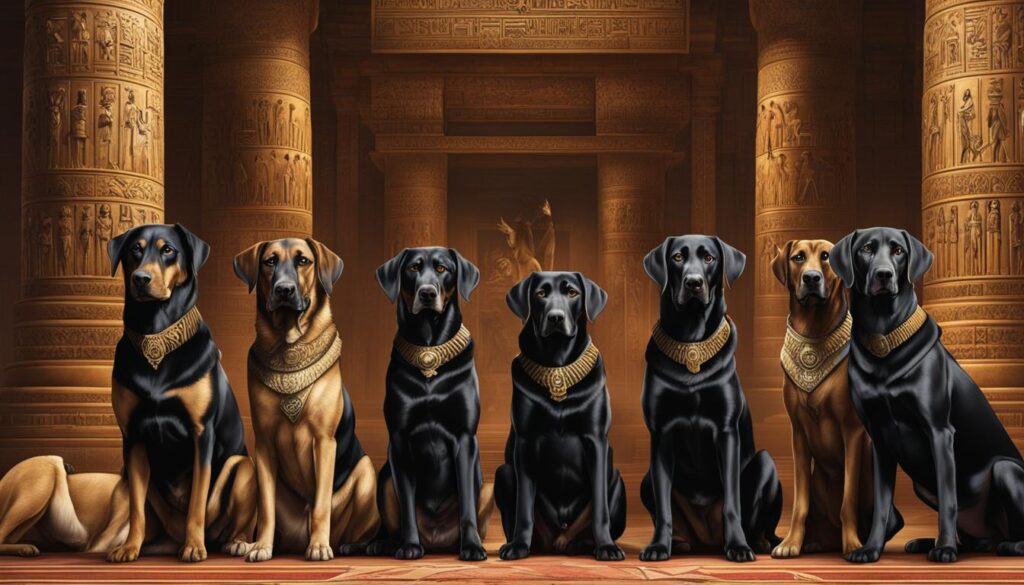
Explore the Mysteries of Ancient Times
Curious to learn more about dogs in ancient civilizations? Journey with us as we delve into the fascinating tales of the xoloitzcuintli, Balto, Laika, Peritas, and more! Uncover the extraordinary ways in which dogs have shaped history and culture throughout the ages.
The Xoloitzcuintli: Ancient Guide and Healing Dog
Ancient Mesoamerican civilizations held the Xoloitzcuintli, also known as the Mexican Hairless dog, in high regard. They played a significant role in the lives of the Aztec and Maya people, serving as guides and healers. The Xoloitzcuintli’s presence can be seen in ancient Mesoamerican art and their importance is deeply rooted in Aztec beliefs.
According to Aztec mythology, the Xoloitzcuintli was believed to have a connection to Xolotl, the god of lightning and death. These hairless canines were thought to be able to guide the souls of the deceased through the treacherous journey of the Underworld. Their unique appearance and healing abilities made them a symbol of protection and spiritual guardianship.
Despite their revered status in ancient times, the Xoloitzcuintli nearly faced extinction in the modern era. However, thanks to dedicated efforts, there has been a revival of this ancient breed. Today, Xoloitzcuintlis are once again cherished and celebrated for their historical significance and unique qualities.
| Key Characteristics | Historical Significance | Modern Revival |
|---|---|---|
|
|
|
The Xoloitzcuintli’s remarkable history and connection to ancient civilizations make them a fascinating breed to learn about. Their role as guides and healing companions provides a glimpse into the rich cultural beliefs of Mesoamerican societies. The revival of this ancient breed serves as a testament to the enduring legacy of these remarkable dogs.
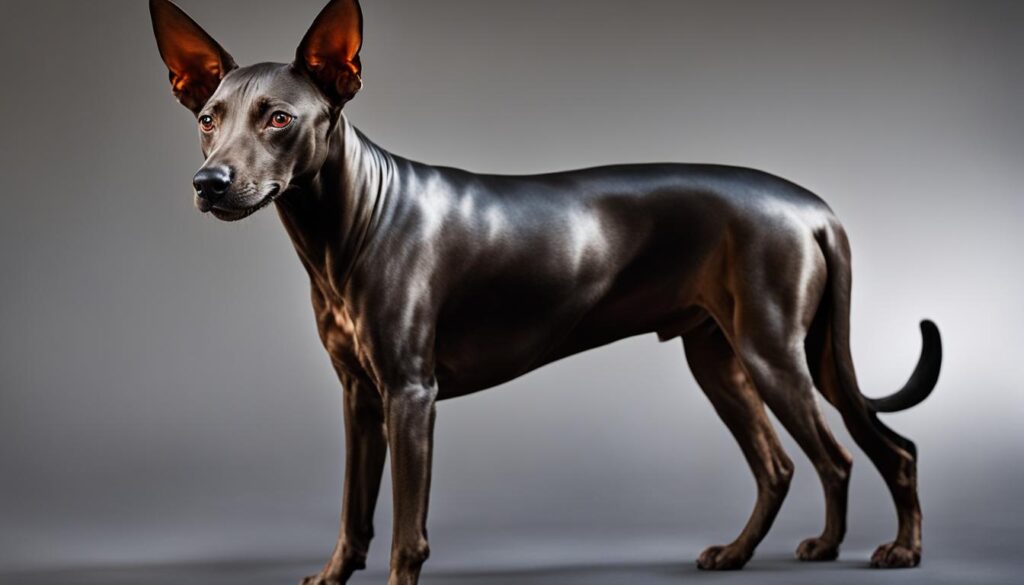
Balto: The Dog that Saved Nome
Balto, a famous sled dog, became a hero during a deadly diphtheria outbreak in Nome, Alaska. In 1925, when the town was cut off from the outside world due to ice blocking the harbor, a shipment of diphtheria antitoxin had to be urgently delivered to save lives. With blizzard conditions and temperatures plummeting to -50 degrees Fahrenheit, a team of sled dogs led by Balto embarked on a treacherous journey.
Braving the harsh elements, Balto and his fellow canines raced against time, traversing over 600 miles of icy terrain. Balto led the final leg of the journey, covering the most dangerous part of the trail, and successfully delivered the life-saving antitoxin to Nome. The heroic efforts of Balto and the other sled dogs saved countless lives and inspired a nationwide admiration for sled dog teams.
In honor of Balto’s courage and determination, a statue was erected in New York City’s Central Park. Today, Balto’s legacy lives on in the annual Iditarod Sled Dog Race, which commemorates the historic event and celebrates the enduring spirit of sled dogs.
“In getting the dogs to Nome, the happiest thought that occurred was the selection of Balto as leader of the team that took the party from Bluff.”
The New York Times
| Key Events | Details |
|---|---|
| Diphtheria Outbreak in Nome | A deadly diphtheria outbreak occurred in Nome, Alaska in 1925, threatening the lives of the residents. |
| Balto’s Heroic Journey | Balto and his fellow sled dogs embarked on a dangerous journey to deliver the life-saving diphtheria antitoxin to Nome, braving freezing temperatures and treacherous conditions. |
| Delivery of Antitoxin | Balto led the final leg of the journey and successfully delivered the diphtheria antitoxin to Nome, saving countless lives. |
| Inspiration for the Iditarod Sled Dog Race | Balto’s heroic efforts inspired the annual Iditarod Sled Dog Race, which celebrates the endurance and bravery of sled dogs. |
Dogs in Ancient Aztec and Maya Civilizations: The Xoloitzcuintli
The ancient Aztec and Maya civilizations held a deep reverence for dogs, particularly the Xoloitzcuintli, also known as the Mexican Hairless dog. These unique canines played an integral role in the beliefs, art, and daily lives of these Mesoamerican cultures.
Aztec beliefs depicted the Xoloitzcuintli as sacred animals, believed to have the ability to guide the souls of the dead through the Underworld to their final resting place. Their hairless appearance and warm skin were associated with healing and protection, making them highly valued companions. In fact, they were often buried alongside their owners to accompany them in the afterlife.
These extraordinary dogs were not only revered in ancient Aztec and Maya cultures but were also prominently featured in Mesoamerican art. Carved sculptures, painted murals, and pottery depicted the Xoloitzcuintli in various scenes, illustrating their significance and deep connection to the spiritual realm.
| Beliefs of the Aztec and Maya Civilizations | Depiction in Mesoamerican Art |
|---|---|
| The Xoloitzcuintli were believed to guide the souls of the dead through the Underworld. | The Xoloitzcuintli were prominently featured in ancient sculptures, murals, and pottery. |
| Their hairless appearance and warm skin were associated with healing and protection. | These depictions showcased the deep reverence and connection between the Xoloitzcuintli and the spiritual realm. |
| They were often buried alongside their owners to accompany them in the afterlife. | Their presence in artwork served as a visual representation of their importance and role in ancient Mesoamerican cultures. |
Unfortunately, the Xoloitzcuintli nearly faced extinction due to the arrival of European colonizers and the introduction of other dog breeds. However, in recent years, there has been a revival of interest in this ancient breed. Today, efforts are being made to preserve and promote the Xoloitzcuintli, ensuring that the legacy of these remarkable dogs lives on.
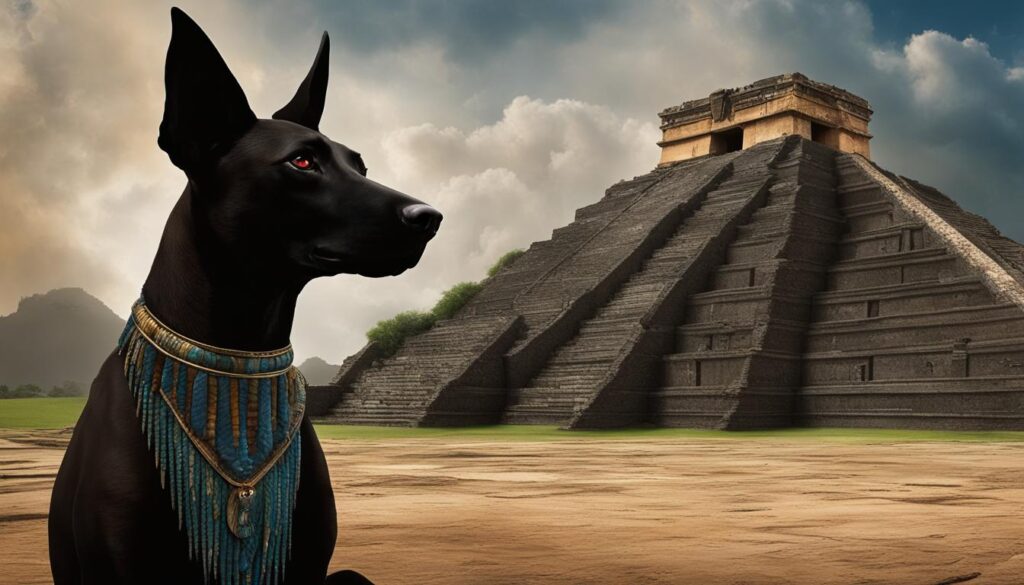
“The Xoloitzcuintli holds a significant place in ancient Aztec and Maya cultures. Their role as spiritual guides and healers, as well as their unique appearance, makes them truly fascinating creatures.” – Dr. Maria Sanchez, Archaeologist
Dogs in Ancient Egypt: The First Animals Domesticated in the Nile Valley
In the realm of ancient civilizations, dogs held a special place in the hearts of the Egyptians. They were not only seen as faithful companions but were also revered for their loyalty and protective nature. Dogs played a crucial role in ancient Egyptian society, serving as watchdogs, hunting companions, and even household pets.
One fascinating aspect of dogs in ancient Egypt was their association with the god Anubis, the deity responsible for guiding souls into the afterlife. Anubis was often depicted with the head of a jackal or a dog, symbolizing his connection to these loyal animals. The Egyptians believed that dogs had the ability to guide the souls of the deceased through the treacherous journey to the Underworld.
“The ancient Egyptians truly revered dogs for their loyalty and protective instincts,” says Dr. Catherine Brown, an Egyptologist at the University of Cairo. “They saw these animals as guardians and guides, not only in their earthly lives but also in the afterlife.”
Ancient Egyptian artwork prominently featured dogs, showcasing their importance in society. Paintings and carvings depicted dogs accompanying their owners on hunts, standing guard at doorways, or curling up at the feet of their human companions. These depictions give us a glimpse into the deep bond that existed between humans and dogs in ancient Egypt.
| Dog Breeds in Ancient Egypt | Role |
|---|---|
| Sighthounds (Saluki) | Hunting |
| Guardian Dogs (Egyptian Mastiffs) | Protection |
| Toy Dogs (Tesem) | Companionship |
Dogs in ancient Egyptian society were so highly regarded that they were often given their own burial sites alongside their owners. These graves, filled with food and other offerings, were a testament to the Egyptians’ belief in the importance of dogs in the afterlife.
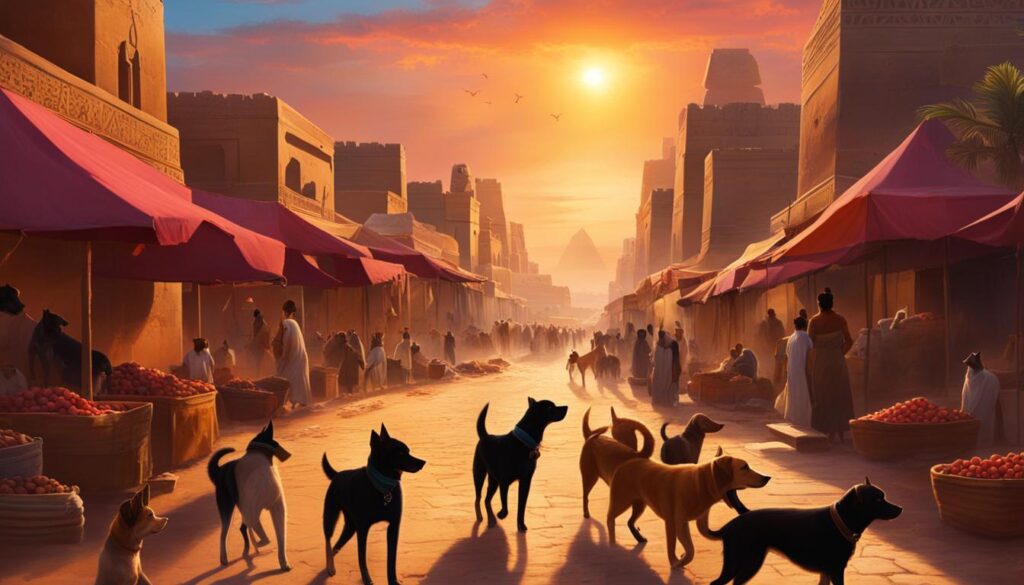
The Legacy of Dogs in Ancient Egypt
Their association with Anubis and their role as faithful companions and protectors made dogs an integral part of ancient Egyptian culture. This deep reverence for dogs continued throughout Egyptian history, with these animals playing significant roles in religious ceremonies, artistic expressions, and everyday life.
“Dogs in ancient Egypt were more than just pets,” explains Dr. Brown. “They were valued members of the family, regarded with great respect and love. Their loyalty and service were honored and celebrated.”
The legacy of dogs in ancient Egypt lives on, reminding us of the enduring bond between humans and our canine companions. From ancient times to the present day, dogs have remained steadfast in their devotion to us, mirroring the love and loyalty that the Egyptians held for their faithful companions.
Peritas: The Dog That Saved Alexander the Great
When it comes to heroic dogs in history, the tale of Peritas, a Molossian breed, stands out as an extraordinary example. In ancient Greece, during a fierce battle in India, Peritas played a crucial role in saving the life of the legendary conqueror, Alexander the Great. As the enemy closed in, Peritas fearlessly fought off attackers, giving Alexander’s troops the precious time they needed to rescue their leader.
Peritas’ act of bravery not only ensured Alexander’s survival but also contributed to the success of his conquests and the shaping of Western civilization. The bond between Alexander and Peritas was undoubtedly strong, as the dog remained by his side throughout numerous military campaigns. This loyal and courageous Molossian breed became a symbol of strength and determination, embodying the spirit of Alexander’s conquests.
“Peritas’ unwavering loyalty and heroic actions exemplify the deep bond between humans and dogs, transcending time and culture.”
Peritas’ story is a testament to the remarkable partnership between humans and dogs throughout history. Their unwavering loyalty and unwavering support have been celebrated across civilizations, leaving a lasting impact on the collective consciousness of humanity. The Peritas legend continues to inspire us, reminding us of the profound and enduring bond between humans and their four-legged companions.
The Peritas Table
| Peritas | Alexander the Great |
|---|---|
| Breed: Molossian | Birthplace: Pella, Macedonia |
| Role: Protector and companion in battle | Role: Conqueror and military strategist |
| Heroic Act: Saving Alexander’s life during the Battle in India | Legacy: Expanding the Macedonian Empire and creating a vast Hellenistic civilization |
Conclusion
Throughout ancient civilizations, dogs have left an indelible mark on history with their remarkable impact and legendary tales. From loyal companions to spiritual guides, these canines held a special place in the hearts and minds of ancient peoples.
Dogs were not only prized for their loyalty and protective instincts but also revered as guides to the afterlife. In ancient Egypt, they were associated with Anubis, the god of death and the afterlife, symbolizing the transition between life and the afterlife.
Similarly, in Mesoamerican cultures, the xoloitzcuintli, also known as the Mexican Hairless dog, was believed to guide the souls of the dead through the Underworld. These ancient beliefs were immortalized in the artwork of the time, showcasing the sacred bond between humans and canines.
Their impact extended beyond the spiritual realm as well. Dogs like Balto, who heroically delivered medicine during a diphtheria outbreak in Nome, Alaska, and Peritas, who saved Alexander the Great’s life on the battlefield, proved their bravery and loyalty time and again, shaping the course of history.
These ancient dog tales continue to captivate our imagination and remind us of the profound bond between humans and dogs. From guiding souls to saving lives, dogs have forever left their paw prints on history, earning them a place as true legends in the annals of time.
FAQ
Did ancient civilizations consider dogs as important animals?
Yes, dogs in ancient civilizations played important roles and were revered as loyal companions, protectors, and even guides to the afterlife.
What roles did dogs play in ancient Egypt?
Dogs in ancient Egypt had versatile roles as watchdogs, hunting companions, and household pets. They were also associated with Anubis, the god of death and the afterlife.
What was the significance of the xoloitzcuintli in ancient Aztec and Maya civilizations?
The xoloitzcuintli, also known as the Mexican Hairless dog, was believed to guide the souls of the dead through the Underworld. They were depicted in ancient Mesoamerican art.
Who was Balto and what did he do?
Balto was a famous sled dog who played a vital role in delivering diphtheria antitoxin to the town of Nome, Alaska during a deadly outbreak. His journey inspired the annual Iditarod Sled Dog Race.
What is the story behind Laika, the first living being to leave Earth’s atmosphere?
Laika was a stray dog from Moscow who was launched into orbit by the Soviet Union in 1957. While her mission paved the way for human spaceflight, there were concerns about her safety and well-being during the journey.
How did Peritas save Alexander the Great’s life?
Peritas, a Molossian dog, fought off attackers during a battle in India, buying enough time for Alexander’s troops to rescue him. This act of bravery contributed to the success of Alexander’s conquests.
What is the overall impact of dogs on ancient civilizations?
Dogs played significant roles in shaping history and culture, acting as loyal companions and protectors. Their stories and legends continue to inspire us today, reminding us of the profound bond between humans and dogs.

